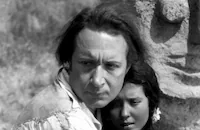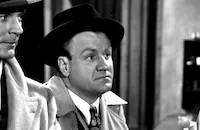My Favorite Blonde

Brief Synopsis
Cast & Crew
Sidney Lanfield
Bob Hope
Madeleine Carroll
Gale Sondergaard
George Zucco
Lionel Royce
Film Details
Technical Specs

Synopsis
Just prior to the entry of the United States into World War II, British agent Karen Bentley takes over the secret mission of her murdered partner to deliver to a British operative in Chicago the encoded flight plan of 100 American bombers. After her ship docks in New York City, Karen eludes enemy agents and slips backstage of a vaudeville theatre. Without revealing her ulterior motive, Karen throws herself at Larry Haines, an actor who performs a vaudeville act with his penguin "Percy." Karen learns that Larry and Percy are taking a train to Hollywood, California, where Percy has a $500-a-week contract to appear in a film, and Larry has a $30-a-week contract as the bird's trainer. To maintain her cover, she accompanies Larry to the train station and slips the medallion of a scorpion, which contains the secret plans, under his lapel without his knowledge, then leaves. The German agents, Mme. Stephanie Runick and Dr. Hugo Streger, are watching, however, and spend the miles between New York and Albany intimidating Larry. Karen boards the train in Albany and Larry concludes that she is crazy because of her erratic behavior. When they disembark for a three-hour layover in Chicago, Karen steals Larry's suitcase containing the jacket with the medallion. He follows her to an apartment where she expects to meet a British agent, but they discover that the agent has been killed and find instructions to continue on to an address in Los Angeles. Karen reveals her true identity and mission to Larry, and aware that they are under surveillance by German spies, Larry and Karen stage a violent "wife-beating" in the apartment to attract the attention of the police, who arrest them and thereby give them safe escort out of the building. The police let the couple go when they "make up" in the back seat of the patrol car, but later chase them because the German agents have framed Larry and Karen for the death of the British agent. While police search the city for Larry, who is billed in newspapers as the "love slayer," Larry and Karen find a safe haven on the rooftop of Union Hall, where they realize that they are in love with each other. The next morning, the couple slip onto a Teamsters' bus headed for a picnic and from there steal the bus, and then a plane, which Karen pilots, to escape the police. When the plane runs out of gas, they land safely in farm country, and are arrested for stealing watermelons. The sheriff soon recognizes them from a police bulletin, and another chase ensues, during which Larry impersonates an obstetrician and gives a lecture to earnest small-town mothers. A freight train carries them to Los Angeles, where they head immediately to the address listed in the instructions, a funeral parlor. The British agent has already been taken hostage by the German agents. However, with quick thinking, Karen and Larry escape from both the agents and the police and arrive at the air force base in time to deliver the secret flight plans that will send American bombers to England. Karen rewards Larry with a kiss.

Director
Sidney Lanfield
Cast

Bob Hope

Madeleine Carroll

Gale Sondergaard

George Zucco
Lionel Royce

Walter Kingsford
Victor Varconi
Otto Reichow
Esther Howard
Edward Gargan

James Burke
Charles Cane
Crane Whitley

Dooley Wilson
Milton Parsons
Erville Alderson
Tom Fadden
Fred Kelsey
Edgar Dearing
Leslie Denison
Robert Emmett Keane

Addison Richards
Matthew Boulton

Bing Crosby
Wade Boteler
William Forrest

Carl "alfalfa" Switzer
Edward Hearn
Leyland Hodgson
Mary Akin
Jack Luden
Harry Hollingsworth
Ed Peil Sr.
Dick Rush

Monte Blue
Jack Clifford
Art Miles
Dick Elliott
Max Wagner
William Irving
Charles R. Moore
Dudley Dickerson
Charles Mcavoy
Arno Frey
Lloyd Whitlock
George Hickman
Rex Moore
Joe Recht
Gerald Pierce
Allan Ramsey
John Erickson
David Mckim
Louis Natheaux
Frank Marlowe
Mike Lally
Frank Mills
Vernon Dent
Sarah Edwards
Paul Scardon
Bill Lally
Pearl Early
Rose Allen
Isabel Randolph
Minerva Urecal

James Millican

Lyle Latell
John Kelly
Jack Gardner
Kernan Cripps
Edmund Cobb
Jimmy Dodd
Richard Keene
Judith Gibson
Phyllis Kennedy
Grace Hayle
Eddie Dew
George Turner
Kirby Grant
William Cabanne
James Ford
John Hiestand
Jack Chapin
Alice Keating
Betty Farrington
Nell Craig
Rita Owin
Crew
Ralph Black
Frank Butler
David Buttolph
Barney Dean
B. G. Desylva
Hans Dreier
Farciot Edouart
Melvyn Frank
Gene Garvin
Don Hartman
Edith Head
Paul Jones
William C. Mellor
Gene Merritt
Norman Panama
William Shea
Robert Usher
Wally Westmore

Film Details
Technical Specs

Articles
My Favorite Blonde
This is a typical Hope role in that his character is a funny man who gets into dangerous scrapes - a formula that never changed too much over his career. In My Favorite Blonde, however, there was at least a small degree of seriousness to the story, a quality which would vanish from his later comedies. In fact, Hope himself complained at the time that he had been getting too many "slapstick and double-take" roles and would appreciate something with more substance and range. According to film historian Lawrence Quirk, the role of Larry Haines in My Favorite Blonde would wind up as one of Hope's all-time favorites for that very reason.
Director Sidney Lanfield and Hope didn't get along too well at first. Both were egotistical control freaks who had different ways of working, but My Favorite Blonde turned out so well (and, more to the point, did so well at the box office) that Hope worked with Lanfield five more times in the years ahead, including The Princess and the Pirate (1944) and The Lemon Drop Kid (1951).
Hope and Carroll are backed up by a wonderful supporting cast that includes horror film veteran George Zucco (The Monster and the Girl, 1941), beautiful Gale Sondergaard, and a pre-Casablanca (1942) Dooley Wilson. Sondergaard had already appeared with Hope in two films, including The Cat and the Canary (1939), and would be back in Road to Rio (1947). Zucco, too, had played in The Cat and the Canary, but director Lanfield remembered Zucco as not having the best feelings toward Bob Hope. Apparently Zucco felt he was being "upstaged" by Hope and derided him as "a clown but not an actor."
As for Madeleine Carroll, Hope was obviously enamoured with her. For months he talked about her constantly on his radio show, with such fervor that finally Carroll herself realized that she could parlay the free publicity into a career-booster. She asked if she could appear on the show. Hope of course agreed, and then took it a step further by asking her to co-star in My Favorite Blonde, which was in pre-production. Now that would be a career booster, for Hope was one of the most popular and powerful stars in town, and Carroll quickly said yes.
The only problem was that Hope, despite being married, really did lust after Carroll. The actress admired Hope as a professional but no more. Worried that her role might be in jeopardy if she rejected him outright, Carroll played it cool and tried to keep her romance with Sterling Hayden quiet. As Lawrence Quirk later wrote, "Carroll¿ tried to handle Hope's bumbling, schoolboy-ish advances as tactfully as possible. Hayden's attitude was more direct: he wanted to show up on set and rearrange the famed ski-nose." Finally, Carroll and Hayden married in a secret ceremony. Hope found out and was privately angry, but Lanfield placated him by reminding him of the great prestige that Carroll's involvement was adding to the production.
Bing Crosby made his first cameo in a Bob Hope movie here, walking on as a truck driver who offers directions. "No, it can't be¿" mutters Hope after Crosby walks away. These cameos in each other's movies, in between all the Road pictures which they had already begun co-starring in, would become a long-running joke in their careers.
Producer: Paul Jones
Director: Sidney Lanfield
Screenplay: Frank Butler, Melvin Frank, Don Hartman, Norman Panama
Cinematography: William C. Mellor
Film Editing: William Shea
Art Direction: Hans Dreier, Robert Usher
Music: David Buttolph
Cast: Bob Hope (Larry Haines), Madeleine Carroll (Karen Bentley), Gale Sondergaard (Madame Stephanie Runick), George Zucco (Dr. Hugo Streger), Lionel Royce (Karl), Walter Kingsford (Dr. Wallace Faber).
BW-79m. Closed captioning.
by Jeremy Arnold

My Favorite Blonde
Quotes
"Is that your real hair or did you scalp an angel?"- Larry Haines
There's no time to lose. Do you know what it feels like to be followed, hounded and watched every second?- Karen Bentley
Well I used to, but now I pay cash for everything.- Larry Haines
Look at me.- Karen Bentley
I'm looking.- Larry Haines
You've got to trust me.- Karen Bentley
Mr. Haines, you're not listening to me.- Karen Bentley
Yes, I am. I said every word you heard.- Larry Haines
Hey, what's this 'Flip and Nip', this 'Floppy Louie' stuff?- Larry Haines
No questions please. I'm being followed by two men in black.- Karen Bentley
You sure you don't mean two men in white?- Larry Haines
Say, you know honey: You and me could make music together. Right now I feel like the philharmonic.- Larry Haines
Trivia
Notes
The film's opening title reads "Bob Hope who calls Madeleine Carroll My Favorite Blonde." The working titles of this film were Snowball in Hell and You're Dangerous. According to information in the Paramount Collection at the AMPAS Library, the airfield scene was shot at the testing field behind Lockheed Aircraft Service Inc., in Burbank, CA. In his autobiography, Bob Hope notes that he hired comedy writers Melvin Frank and Norman Panama for their first jobs for his 1938 radio show, and that they wrote for him for a year. They went on to write for the Bob Hope-Bing Crosby "Road" pictures. My Favorite Blonde was so popular that Paramount considered releasing a sequel called My Favorite Brunette, according to Hollywood Reporter news items. Although the sequel was never made, Paramount used the title for a 1947 film starring Hope, Dorothy Lamour, Peter Lorre, Lon Chaney, and a host of other Paramount stars (see below). Hope reprised his role in a October 19, 1942 Lux Radio Theatre broadcast of the story, co-starring Virginia Bruce.

Miscellaneous Notes
Released in United States 1942
Released in United States on Video May 19, 1993
Released in United States 1942
Released in United States on Video May 19, 1993














